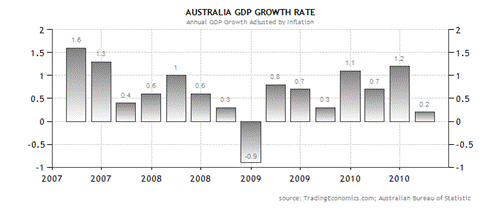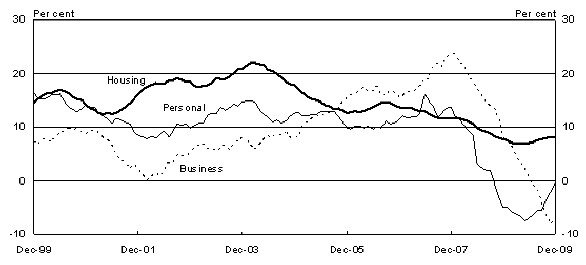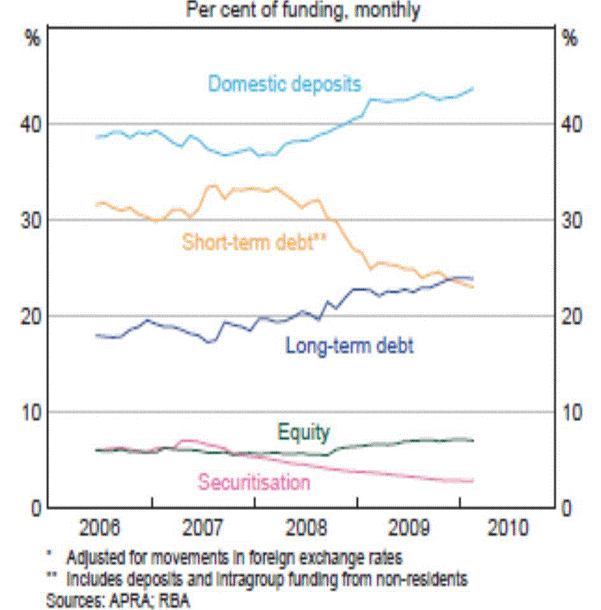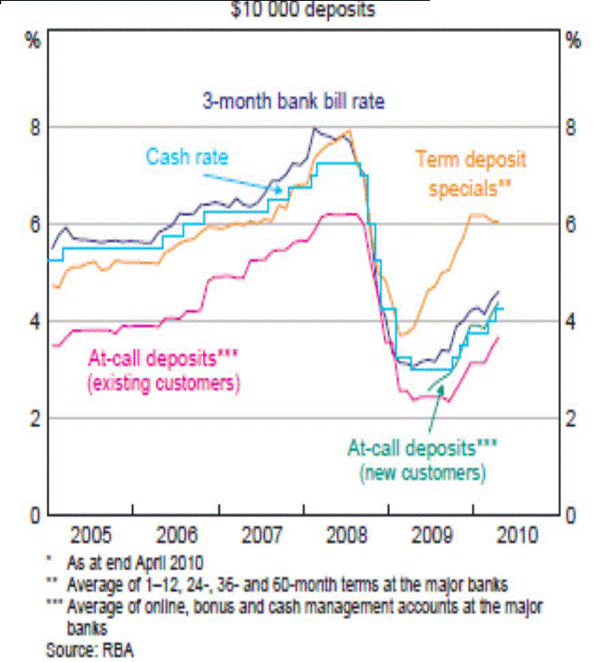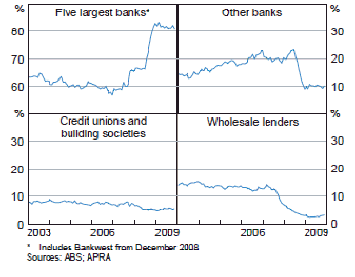Money and Capital Market Assignment Help

Subject: The Impact of Global Financial Crisis on Australian Financial System. The topic given to us will help to apply our theoretical knowledge in analyzing a current financial market related issue especially in Australia.
Executive Summary
The following paper discusses the impact of GFC on Australian financial system. Though GFC spread irrespective of individuals, country and industry, still its effect on Australian economy was least because of the strong government regulations and powerful equity market which served as an alternative to the SMEs in times of downturn. In this paper, first of all we have discussed what a credit crunch is and how it led to global financial crisis, then how it impacted the Australian Financial System is discussed and in the later part of the report we have discussed the responses to GFC and the post recession impact on the Australian Banking system.
What is a Credit Crunch?
Source: http://www.globalissues.org/article/768/global-financial-crisis
Credit crunch is defined as “A sudden reduction in the availability of loans and other types of credit from banks and capital markets at given interest rates. The reduced availability of credit can result from many factors, including an increased perception of risk on the part of lenders, an imposition of credit controls, or a sharp restriction of the money supply.
Or
Slang for a general economic condition in which loans are harder to obtain. (Teach Me Finance.com)
The year 2008 saw a major credit crunch. While the signs of slowdown began to surface in US since the second quarter of 2008, it was the going down of Lehman Brothers in September 2008 that the entire world economic system went into disarray. It is widely believed that the genesis of the slowdown was the excessive use of credit default swaps in the US housing market which helped rise of toxic security. Since the US banks had lent excessively in the housing sector, it resulted in the prices going up to unrealistic levels. As a result when the markets started tumbling down, many banks found huge loan defaults. This impacted the liquidity in the system as banks stopped lending completely throwing the economy out of gear. Since there was no capital requirement on credit default swaps, the banks found that they are excessively leveraged when the derivatives went into losses. This impacted the solvency of many financial institutions such as Lehman Brothers, which in turn resulted into a major global economic recession. The banks stopped lending to each other as they grappled with the extraordinary situations and feared a lot of large financial institutions would go down under. This created a Credit Crunch – and all types of lending virtually stopped bringing the whole economy into a grinding halt. GFC though triggered by collapse of Lehman Brothers in 2008 but spread to the entire world. Governments around the world struggled to rescue giant financial institutions as the fallout from the housing and stock market collapse worsened. Financial institutions faced serious liquidity issues as a result governments of all countries announced stimulus packages to boost their economies. The impact of GFC on the GDP of the countries worldwide is shown below:
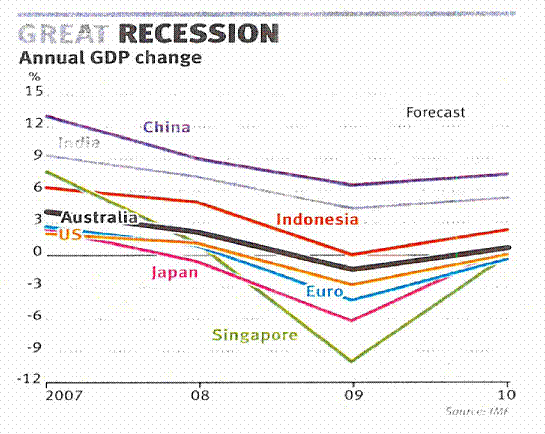
What is a Financial System?
Financial system refers to the monetary part of an economy and includes activities like savings, investments, borrowings, lending etc. The financial system is comprised of players like banks, stock market, debt market, insurance companies, mutual funds, non banking financial companies, Central Bank etc. Every country needs a safe and vibrant financial system to facilitate a smooth and efficient flow of money from savers to investors. It is important for the prosperity of the country as a whole. The financial system:
- facilitates payments;
- supports countrymen so that they can invest and save for retirement;
- enables households to save for, and purchase, housing; and
- Ensures that capital is allocated efficiently, supporting investment in essential infrastructure.
Australian Financial System
During the financial global crisis, the Australian financial system has been the most resilient system in the GFC than other but Australia also experienced a change in the competitive dynamics of the banking system as an effect of GFC.
Australia's financial system worked well throughput the global financial crisis. Overall, Australia's institutions remained profitable and well-capitalized, and this allowed them to continue to lend throughout the crisis. Even so, intermediated credit from the banking sector became more expensive and subject to tighter conditions. Borrowers especially the small and medium sized organizations were able to supplement their borrowing needs by borrowing money from the debt and equity capital market; other small businesses which could not get access to these financial alternatives were the most affected by the tightening of credit conditions.
The banking sector of Australia could survive in tough financial conditions due to the following strengths.
- Unlike the other banks abroad, Australian banks were comparatively low exposed to high risk assets;
- Another factor was the powerful equity market which served as the best alternative for banks to raise large amounts of equity in 2009;
- The quality of financial regulatory system and
- The numerous attempts by the Reserve Bank of Australia and Australian Government to beat Global Financial Crisis. For example, as a measure to avoid Australians to go into major Recession, interest rates in Australia were cut to the lowest level in the last 50 years. The first significant step taken by RBA was the cutting in interest rates by 100 basis points. This financial stability measure effectively involved the Government taking on risk to ease consumer and business concerns about the financial sector and more broadly economic conditions. In this highly volatile and risk-averse environment where there was the potential for disorderly and irrational behavior, it was essential that governments calmed the situation by temporarily taking on private sector risk. (Dr. Steven Reddy, 2009) This decrease in interest rates resulted in decrease of cost of borrowings for both consumers and corporate sector; as a result it had a positive impact on the demand of goods and services particularly those which are interest rates sensitive.
The central banks also to overcome financial crisis cut rates very quickly, the overnight cash rate was cut 425 basis points to an “emergency level” of 3% eased out not only the consumers but also stabilize the Australian financial system and secure flows of credit to the economy (Varun Chhabra 2009). Later on when emergency passed on, the Reserve Bank of Australia lifted the official cash rate by 0.25 percentage point to 3.5% on 3 November 2009. This follows a rise in October 2009, with more expected (Jo Jackson, 2009).
The Australian Government as a result to the Global Financial Crisis delivered its first budget focusing on policies to tighten inflation; the government in order to boost the economy announced two stimulus packages, first one of $10.4 billion and when the situation was still not under control, it announced a larger stimulus package of $47 billion to help the economy;
- $14.7 billion for schools
- $6.6 billion for 20,000 new homes
- $3.9 billion to insulate 2.7 million homes
- $890 million for road repairs and infrastructure
- $2.7 billion in small business tax breaks
- $12.7 billion for cash bonuses: $950 for every Australian taxpayer who earned less than $80,000, to be paid out in March and April 2009
The introduction of these two stimulus packages by the Australian Government of $10.4 billion and $42 billion provided a boost to the economy of” ½ per cent of GDP in 2008‐09 and around ¾ to 1 per cent of GDP in 2009‐10.” The same can be seen from the graph below:
Restore liquidity: RBA expanded range of repo securities to include private sector securities such as RMBS. Term for re purchase agreements extended up to 12 months. Sept. ’08, establish the Australian Office of Financial Management for objective of purchasing RMBS - “restarting” the frozen RMBS market.
Build confidence: October ‘08 blanket guarantee of all bank deposits and debt. Fee based, opt-in guarantee scheme (for debt and deposits above $1 million) together with 100% guarantee for deposits <$1 m introduced November ‘08 for three years.
Reduce further instability: Ban on short-selling on the ASX Sept. ‘08 on all stocks until 19th November and to financial stocks until May 25, ‘09. Tougher regulation of margin lending also foreshadowed.
Apply stimulus: October ‘08 fiscal stimulus package announced and official interest rate reductions to offset economic slowdown, federal guarantee scheme for borrowings by the State and Territory Governments for debt funding of infrastructure.
Bail outs: No action
The Flow of credit during the Global Financial Crisis
There were concerns that during the height of GFC in 2008, there will be extreme dislocation in the financial market forcing the financial institutions to ratio credit but this did not take place to a greater extent, rather the total housing credit registered a growth of 8.2% in 2009 as shown in the chart below:
Chart 1: Credit by sector
Year-ended percentage change
Credit flows to other sectors such as business have decrease but taking into account other sources of financing – that is, intermediated credit, equity, and non-intermediated debt such as corporate bonds – businesses’ net stock of external funding increased over 2009.
As the price of intermediated credit increased, businesses elected to diversify their funding. This compares favourably with the experience of the early 1990s where the fall in intermediated credit was not fully offset by increases in non-intermediated debt and equity issuance.
Impact on Banking System of Australia
Though the Banking system was relatively strong but the three main components of GFC affected Australia also, the three components are: a ‘drying up’ of liquidity, an upward re pricing of risk and a requirement for more capital. The effect on the banking sector is shown below:
Challenges in the post global financial environment
The Government's recent announcement of the removal of the Guarantee Scheme for Large Deposits and Wholesale Funding from 31 March 2010 is a further positive indication that Australia’s financial system is on an upturn. At the current time, there are two key issues at the forefront of the policy agenda for the Australian financial system. The first concerns the competitive dynamics of the banking sector. And the second concerns the implementation of international enhancements to financial regulation and supervisory practices.
Some recent trends in the banking sector have raised concerns about the competitive dynamics of the sector following the global financial crisis.
- The banking sector has become more concentrated since the onset of the crisis.
- While all of Australia's financial institutions have experienced a drop in profits as a result of the crisis, the fall has generally been more pronounced for smaller institutions.
- The major banks’ net interest margins increased over the crisis.
The major banks’ market share of most products increased over the course of the crisis. This chart (Chart 3) shows that the share of owner-occupier housing loan approvals for the five largest banks – the majors plus St George – increased from around 60 per cent before the onset of the financial market turbulence in mid-2007 to around 82 per cent.
Chart 3: Share of owner-occupier loan approvals
By lender, seasonally adjusted
Impact of recent trends on the competitive dynamics of the sector
While it is difficult to be definitive, especially because interest rate margins will be affected by changes in perceptions of risk, the evidence suggests some diminution of competitive pressures over the past couple of years. Any weakening in competitive pressures would naturally be of concern to policymakers as well as customers.
However, notwithstanding the funding difficulties faced by some participants, there is evidence of some continued competitive pressures on interest rates, especially for mortgages. For example, a significant number of smaller lenders, including mutual credit unions and building societies, are offering standard variable mortgages at rates of up to one per cent less than the majors.
And as global financial markets continue to recover, we expect to see competitive pressures in the banking sector rebuild. In particular, smaller institutions can be expected to be in a position to increase their competitive influence over time as securitisation markets recover, supported by the Government’s direct investment in residential mortgage backed securities.
Further, some smaller domestic institutions that have been forced to scale back lending can be expected to become stronger competitive forces as their balance sheets recover.
Foreign banks will also be able to re-establish their presence in Australia as conditions in their home markets stabilise, although this could be a protracted process, depending on the pace of the global recovery.
It is these smaller players that have generated the most significant competitive pressure in Australia’s banking sector. They have helped significantly in creating a strong competitive dynamic.
So that consumers might have access to a highly innovative and dynamic banking sector and pay lowest possible prices for banking products, it is important that we see a return of this competitive dynamic.
International Financial Regulation Enhancements
As Australia emerges from the global financial crisis, there is a second area that poses challenges. This is the implementation of international financial regulation changes -- a high priority for the G20.
The global financial crisis demonstrated severe weaknesses in financial regulation in some markets. In particular, it exposed insufficient capital, too little attention to liquidity and adverse incentives for the executives of some institutions that encouraged inappropriate risk-taking. It also highlighted weaknesses in accounting standards.
The G20, the Basel Committee on Banking Supervision, the Financial Stability Board and the International Monetary Fund are the key international bodies that are developing rules and regulations designed to create a more robustly regulated global financial system.
The Basel Committee on Banking Supervision released proposals for consultation in December 2009. These focused on tightening up institutions’ capital and liquid asset holding requirements.
These proposals require institutions to hold higher quality capital predominately in the form of ordinary equity, which is genuinely loss absorbing. There would also be limits on the amount of hybrid capital that institutions can hold to meet their capital requirements.
Other proposals involve the introduction of counter-cyclical capital buffers and a supplementary leverage ratio.
Strengthened liquidity rules would require institutions to hold more and higher-quality liquid assets to survive a longer period of severe market stress. These measures would make banking systems more stable and less exposed to external shocks.
Conclusion
Australia's banking sector is in a sound position to continue to support growth in the economy and to meet the challenges Australia will face over the coming decades. As the economy and financial markets recover, we want to see competitive pressures in the sector increasing. Given the financial system’s key role in the economy, we cannot be complacent. It is important that we continue to monitor the competitive dynamics of the banking sector closely and continue to empower consumers. In addition, the global financial crisis has given us the opportunity to strengthen our financial regulation further to safeguard against future financial crises, whilst also making sure that regulation is appropriate.
References
- Jo Jackson, Nov 3, 2009, Reserve Bank of Australia Lifts Cash Rate Again, retrieved from:
- Dr. Steven Reddy (2009), Australia's response to the global financial crisis, Australian Government, The Treasury, on 4-01-2011
- Tony Makin, 2010, G20'S Keynesian group think bungled GFC
- The impact of Global financial crisis
- Varun Chhabra, RBA Economics Competition 2009, Policy Responses to the Global Financial Crisis
- Australia GDP Growth Rate, retrieved from; http://www.tradingeconomics.com/Economics/GDP-Growth.aspx?symbol=AUD
- Dr. Ken Henry, Secretary to the Treasury, 2010, ‘The Australian Financial System Emerging from the Global Financial Crisis’ retrieved from: Ken Henry speech to the Count Financial Canberra Conference
- Global Financial Crisis - What caused it and how the world responded, retrieved from: http://www.canstar.com.au/global-financial-crisis/
- THE IMPACT OF THE GLOBAL FINANCIAL CRISIS
- Session Nick Vamvakas
Appendix 1:
Impact of the GFC –Global Banks
Market Values in $ Billion
| Morgan Stanley | RBS | Deutsche Bank | Credit Agricole | Societe Generate | Barclays | BNP Paribas | Uni credit | |
| Q2 2007 | 49 | 120 | 76 | 67 | 80 | 91 | 108 | 90 |
| Jan-09 | 16 | 4.6 | 10.3 | 17 | 26 | 7.4 | 32.5 | 26 |
| UBS | Credit Suisse | Goldman Sachs | Santander | Citigroup | JP Morgan | HSBC | CBA | |
| Q2 2007 | 116 | 75 | 100 | 116 | 255 | 165 | 215 | 68 |
| Jan-09 | 35 | 27 | 35 | 64 | 19 | 85 | 97 | 43 |


